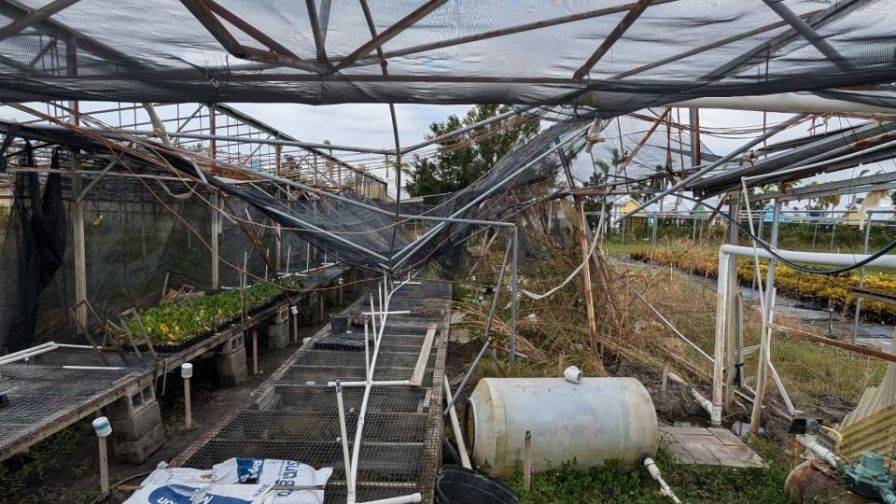Hurricanes Helene and Milton delivered a big blow to many farm operations and growers across the Southeast U.S. Luckily, a multitude of disaster aid resources are available from USDA, local/state government entities, ag industry associations, and more. However, along with disaster recovery comes challenges that can complicate and/or delay receiving funds to get growers back on their feet. For example, the Small Business Administration’s Disaster Loan Program recently ran out of funding in the wake of Helene and Milton. As of this post, reports indicate a group of senators have submitted a plan to help replenish the program. Stay tuned. Beyond the usual means to recover after a disaster, the concept of crowdfunding is gaining ground in scale and scope.
Crowdfunding Efforts in the Wake of Recent Hurricanes
To date, more than 550,000 people across the U.S. have donated to hurricane relief efforts in the wake of Helene and Milton, with the average donation amount of $120, according to a GoFundMe spokesperson who reached out, adding “Our hearts go out to everyone impacted by Hurricanes Helene and Milton, and those across the agricultural community. We have established the Hurricane Helene Relief Hub, which features thousands of GoFundMe fundraisers, including hundreds for farms, that have been verified for emergency relief and long-term rebuilding.”
GoFundMe’s Hurricane Relief Fund has raised more than $1 million so far. The donations are tax-deductible and provide immediate relief grants to people impacted by hurricanes who are seeking help through verified GoFundMe fundraisers, as well as to nonprofit organizations that are supporting efforts on the ground.
There are countless stories to tell for growers directly impacted by the recent hurricanes. Some of those stories are being shared via the crowdfunding community. Here are several examples of GoFundMe crowdfunding campaigns set up to help growers in need after hurricanes Helene and Milton:
How Does Something Like GoFundMe Work?
GoFundMe is defined as a community-powered fundraising platform designed to help people help each other. Like other crowdfunding platforms, individuals or groups can set up campaigns for people, communities, organizations, businesses, and more that need support due to any number of circumstances. These platforms are set up to get as much money as possible to the fundraiser recipient by setting goals. Additionally, GoFundMe doesn’t charge organizers any fees to set up or run a fundraiser.
Crowdfunding has become more prevalent following natural disasters. With that comes the inherent risk of fraud. According to the GoFundMe spokesperson, they have a team that specifically monitors and verifies fundraisers during humanitarian disasters and other crises. “Our dedicated team of ‘Trust and Safety’ experts are working around the clock to verify fundraisers related to Hurricanes Helene and Milton.”
How To Set up a GoFundMe
Setting up crowdfunding campaigns is easier than you think. GoFundMe provides helpful tips for a successful fundraiser. Here are a few to get you started.
- Write a descriptive fundraiser title: Your fundraiser title is usually the first thing people see.
- Be as detailed as possible in your fundraiser story: When writing your fundraiser story, be specific about what you are fundraising for whenever possible, and tell a compelling story in honest and heartfelt words.
- Choose high-quality photos for your fundraiser: One of the best fundraising tips is adding high-quality, personal photos to your fundraising page to help potential donors connect with your story.
- Use suggested goals: GoFundMe suggests a goal amount based on fundraisers with similar locations, categories, etc. that found success on the platform in the last year. You can always choose a goal amount different from our suggestion, and edit your goal.
- Spread the news about your fundraiser in different ways: Sharing your fundraiser in many different ways helps increase its visibility. You can use the social media “Share” buttons on your GoFundMe to share your fundraiser via your preferred channels.
- Be specific when sharing your fundraiser: Avoid simply sharing the fundraiser link. Include a sentence or two about why you are fundraising to help donors understand your goals.
- Post regular updates to your fundraiser: Post an update to your fundraiser within seven days of starting it. Then continue doing so every week or at major milestones to keep donors engaged and encourage them to keep sharing.
Lastly, be sure to thank your donors. For more details on these tips, click here.
Giving help can be easy. Asking for help can be difficult. When it comes to coping in the face of adversity, help – no matter how big or small – is appreciated.
Hurricane Recovery Aid and Resources
As recovery continues in the wake of Hurricanes Helene and Milton, Meister Media Worldwide strives to provide important grower information and resources for assistance. Click here to explore resources now.

